Optimized, Customized 3D-Printed Steering Wheel for Baja SAE
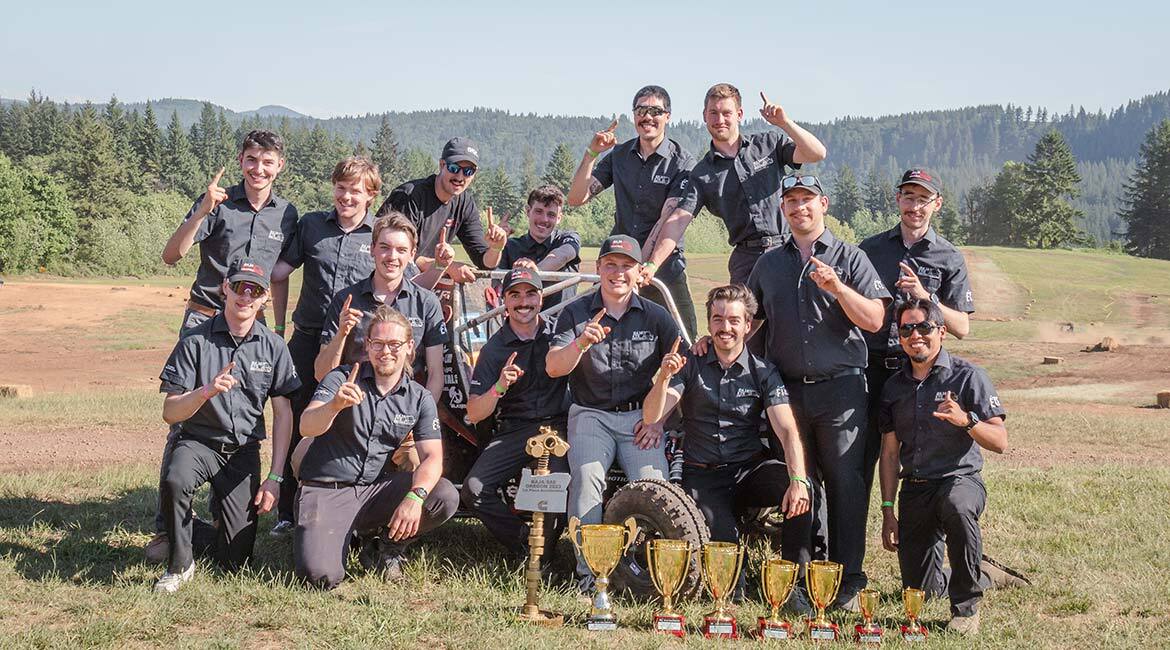
@Baja.
Among the student clubs at École de technologie supérieure, Baja ÉTS is the one that has earned the most competition awards since its inception in 1989. The club designs, builds and validates an all-terrain vehicle called the Baja.
For the project described in this article, the Baja ÉTS team used additive manufacturing (AM) technology, and the AM expertise and infrastructure available at ÉTS. It is worth noting that the first AM course in Canada was offered at ÉTS in 1995 by Professor Sylvie Doré, as an optional course in the Bachelor of Mechanical Engineering program. Since then, AM courses offered at ÉTS have expanded, now including courses at the graduate level. ÉTS is also equipped with a state-of-the-art platform for metallic and polymeric AM.
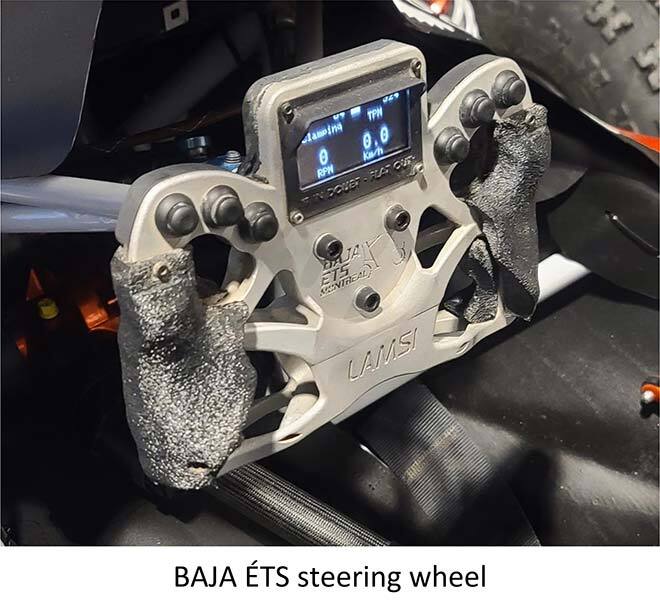
Baja SAE
Like a side-by-side all-terrain vehicle, the Baja participates in competitions featuring nearly a hundred world-class teams at events hosted by the Society of Automotive Engineers (SAE). Each competition lasts four days, during which acceleration, handling, suspension and load-pulling capacity are put to the test. The competition culminates in a four-hour endurance test, during which the Baja must tackle rough terrain, rocks, hills and other obstacles. In addition, each competition evaluates the engineering skills of the students, who have to complete design, cost and sales presentations.
The year 2023 brought many challenges as a new, more powerful, heavier engine was installed and commissioned. The overall design objective was to achieve acceleration over 100 feet in less than four seconds (time achieved: 3.8 s) while keeping vehicle weight below 360 lb (current weight: 350 lb). For 2023, the Baja team introduced a number of innovations, including a new adjustable front suspension system, more aerodynamic styling, three downshift speeds for improved throttle response, and a new, stronger and more ergonomic steering wheel, which is the subject of this article.
The Baja steering wheel: Problems and solutions
For some time now, the Baja ÉTS has had problems with one essential system: its steering wheel. The wheel made from a cut aluminum plate had proved inadequate, breaking several times in previous years (see figures below).
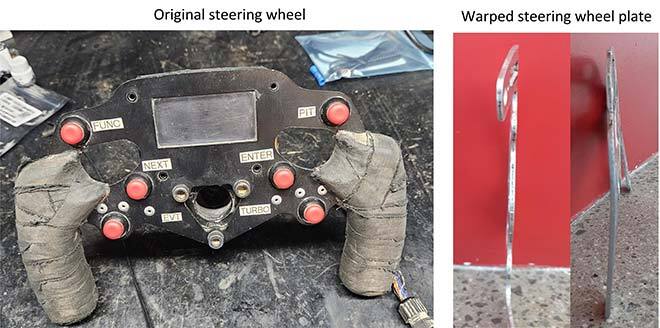
To solve the steering wheel’s reliability problem, the Baja team turned to the Shape Memory Alloys and Intelligent Systems Laboratory (LAMSI). During discussions, four steering wheel optimization criteria were listed: a) Maximize steering wheel stiffness/weight ratio; b) Increase steering wheel resistance to mechanical stress, both impact and fatigue; c) Improve ergonomics of the driver’s grip on the steering wheel (customization); d) Simplify steering wheel assembly.
Additive manufacturing concepts applied to steering wheel design
To carry out the preliminary design of the new steering wheel, it felt appropriate to call on the students from the additive manufacturing courses: MEC627 Additive Manufacturing Technology (Fall 2022) and SYS816 Additive Manufacturing of High Value-Added Components (Winter 2023). As part of the semester projects, students had to put into practice the concepts seen in class, namely reverse engineering and customization, topological optimization—a mathematical method to optimize material distribution in a given volume subject to mechanical loads—and design and additive manufacturing of metal and polymer parts.
Steering wheel design objectives
Three design objectives were formulated by the LAMSI and Baja teams, namely a) Consider the three load cases for topological optimization: left and right turns, braking, impact or landing; b) Integrate, optimize position, and customize steering wheel handles; c) Protect the steering wheel’s electronic components from the elements.
As shown in the figure below, the first step was to define the areas to be optimized (Blue) and those to be overlooked (Red). From there, applying the loads established in the specifications and obtaining a simulation result was possible. This “optimized” result was then transferred to computer-aided design (CAD) software to create the 3D model and add other design elements, such as covers for the electronic components. The final step before manufacturing was to validate the steering wheel’s static and fatigue resistance using finite element analyses.
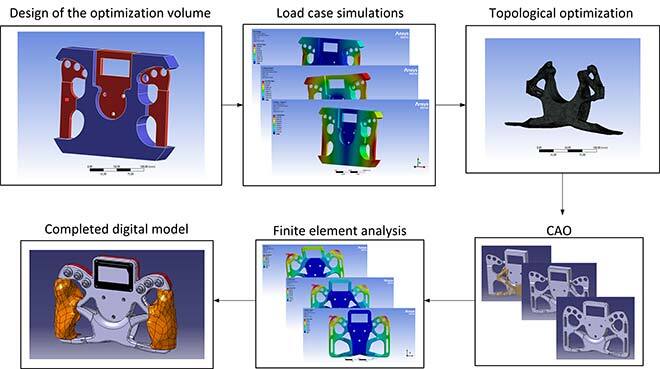
Along with the mechanical design of the steering wheel, the team at TT Fabrication 3D—a Montreal-based startup founded by an ÉTS alumnus who specialized in 3D design and printing—took charge of designing and manufacturing the customized handles. The optimized steering wheel was installed on the vehicle, with clay-coated handles so they could be moulded to the driver’s hands. The customized handles were then digitized using a 3D scanner and added to the complete steering wheel model.
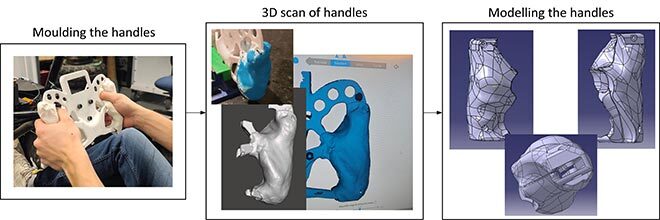
Once the specification requirements were met, the steering wheel was printed in aluminum using the metal laser powder bed fusion (LPBF-M) technology. The electronics box covers were printed in polyamide using the polymer laser powder bed fusion (LPBF-P) technology. These parts were then dyed in the Baja ÉTS colours. The customized handles were printed in thermoplastic polyurethane on a filament extrusion machine and mounted on the steering wheel.
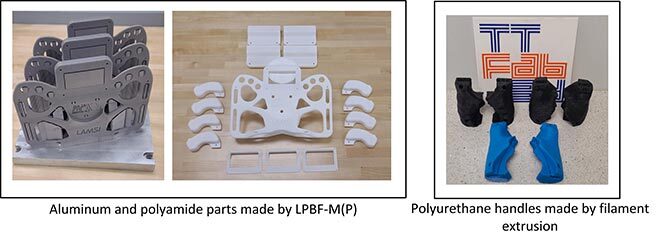
The final product is a customized, ergonomic steering wheel, 1.5 times more resistant to braking and 136,000 times more resistant to driving in bends than the original, despite an additional 270 grams—the total weight of the fully equipped steering wheel is 2 kg 300 g.
Conclusion
This complex project put the metal and polymeric 3D printing technologies available at ÉTS into a practical context as part of semester projects for the undergraduate and graduate courses. Although slightly heavier than the original steering wheel, the new 3D-printed steering wheel was an instant hit with the Baja ÉTS drivers and is now considered a solid foundation for further improvements to this vital part of the vehicle. This year, Baja ÉTS took second and first place overall at the Oshkosh and Oregon competitions. The team is now one of the three world championship finalists, and the winner will be recognized after the Ohio Competition in September 2023. As for the AM courses offered at ÉTS, they are attracting growing interest from the student community: since 2015, over 400 students have taken the course, which effectively combines theory and practice.
Acknowledgments
Baja ÉTS and LAMSI would like to thank the students of the MEC627 (Additive Manufacturing Technology) Fall 2022 semester and the SYS816 (Additive Manufacturing of High-Value-Added Components) Winter 2023 semester. Their efforts and creativity led to solving the steering wheel breakage problem.



